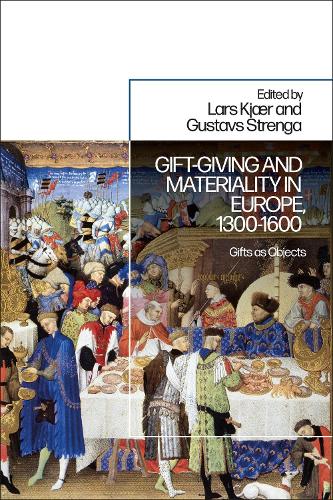
Gift-Giving and Materiality in Europe, 1300-1600: Gifts as Objects
(Hardback)
Available Formats
Publishing Details
Gift-Giving and Materiality in Europe, 1300-1600: Gifts as Objects
By (Author) Dr Lars Kjaer
Edited by Dr Gustavs Strenga
Bloomsbury Publishing PLC
Bloomsbury Academic
6th October 2022
United Kingdom
Classifications
Tertiary Education
Non Fiction
Social and cultural history
Material culture
394
Physical Properties
Hardback
272
Width 156mm, Height 234mm
Description
Gift-giving played an important role in political, social and religious life in medieval and early modern Europe. This volume explores an under-examined and often-overlooked aspect of this phenomenon: the material nature of the gift. Drawing on examples from both medieval and early modern Europe, the authors from the UK and across Europe explore the craftsmanship involved in the production of gifts and the use of exotic objects and animals, from elephant bones to polar bears and living holy objects, to communicate power, class and allegiance. Gifts were publicly given, displayed and worn and so the book explores the ways in which, as tangible objects, gifts could help to construct religious and social worlds. But the beauty and material richness of the gift could also provoke anxieties. Classical and Christian authorities agreed that, in gift-giving, it was supposed to be the thought that counted and consequently wealth and grandeur raised worries about greed and corruption: was a valuable ring payment for sexual services or a token of love and a promise of marriage Over three centuries, Gift-Giving and Materiality in Europe, 1300-1600: Gifts as Objects reflects on the possibilities, practicalities and concerns raised by the material character of gifts.
Reviews
This deeply learned and theoretically nuanced collection of essays explores the importance of materiality in the study of gift and counter-gift. From rings to chairs to banners, relics, elephant bones, and ones self, the specificity of the object given was essential in creating the lasting relationships cemented in gift exchange, ensuring that the giver remained physically present with the receiver. And yet these objects had lives of their own, their significance changing over time in relationship to the communities that preserved them. The essays discuss not only the gifts themselves but objects such as poor boxes and images that were integral to gift-giving. Spanning the late Middle Ages to the early modern period, the volume also considers the changing meaning of gift giving brought about by the Reformation. * Patrick Geary, Professor Emeritus, Institute for Advanced Study, US *
Gift-exchange, long treated as the motor of social relations in archaic societies, is brought to fresh life in these innovative and reflective essays. They return us to the emotional content of the gift and bring out the special qualities of the material objects that made gifting so attractive. The collection sweeps right across Europe in the late medieval and early modern periods. Its breadth and originality make it both fascinating and compelling. * Paul Fouracre, Professor Emeritus, University of Manchester, UK *
Author Bio
Lars Kjaer is Associate Professor in Medieval History at the New College of the Humanities, UK. He is the author of The Medieval Gift and the Classical Tradition (2019) and the co-editor of Denmark and Europe in the Middle Ages (2014). Gustavs Strenga is a Postdoctoral Researcher at University of Greifswald, Germany. He has previously worked as a Postdoctoral Research Fellow at Tallinn University, Estonia, and Researcher at the National Library of Latvia.
